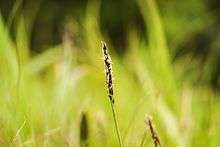Zoysia japonica
Zoysia japonica (commonly known as Korean lawngrass,[1] zoysiagrass or Japanese lawngrass) is a species of creeping, mat-forming, short perennial grass that grows by both rhizomes and stolons.[2][3] It is native to the coastal grasslands of southeast Asia and Indonesia.[4] The United States was first introduced to Z. japonica in 1895. It received its first import from the Chinese region of Manchuria.[3] Today, Z. japonica has become one of the most widely used species of turfgrass in the United States, serving as a close alternative to bermudagrass.[5][6]
| Zoysia japonica | |
|---|---|
| Cultivated Zoysia japonica | |
| Scientific classification | |
| Kingdom: | Plantae |
| Clade: | Tracheophytes |
| Clade: | Angiosperms |
| Clade: | Monocots |
| Clade: | Commelinids |
| Order: | Poales |
| Family: | Poaceae |
| Genus: | Zoysia |
| Species: | Z. japonica |
| Binomial name | |
| Zoysia japonica Steud. | |
Morphology/characteristics
Zoysia japonica has smooth, stiff, vertical leaf blades that roll in the bud.[5][7] It grows to around 0.5 mm in width, and is hairy near the base and exhibits short inflorescences. The pedicles grow to about 1.75 mm, while the ascending culm internodes measure to roughly 14 mm long.[4] Z. japonica has a very coarse texture, compared to others of its genus.[3] Its high tolerance to drought, freezing temperatures, salt, and shade make for a favorable lawn grass.[3][8][5] An adventitious root system grounds the grass.[2] When exposed to prolonged drought, it easily adapts by developing deeper rooting systems.[9] Although it is tolerant to freezing temperatures, it does lose its bright green color, turning brown after frost.[8]
Climate and regions
Zoysia japonica needs a humid climate to survive. It does well in cool temperate zones, transition zones, and warm temperate or marine zones.[10] It was originally cultivated such climates in China, Japan, and Korea.[2] In the United States, it is cultivated south of Connecticut, along the Atlantic Coast, and along the Gulf Coast to Texas. In Australia, it is cultivated along the northeastern coastline.[7]
Cultivation
Although Z. japonica is one of the only Zoysia species that can be seeded, it has a lengthy germination rate of at least a month, so vegetative planting is the primary form of cultivation.[10][8] Z. japonica seeds require a moist environment and a temperature of at least 70 °F to germinate, and therefore sod, sprigs, and plugs are less prohibitive methods of planting.[10][8] Nevertheless, sod is sold at a steep price.[10] Although it can be planted at almost any time of year, late summer planting is discouraged.[10]
Upkeep of Z. japonica varies based on uses, in general requiring a moderate level of nitrogen fertilizer to keep its density. Treatment should be planned for early spring or late fall. On average, it requires 1.0-1.5 inches of irrigation a week.[3] Experts suggest that it is mown to a height of 0.5-2.5 inches every 5–10 days.[5] Z. japonica is nearly resistant to disease, yet is subject to insect attack from white grubs.[3]
Cultivars
'El Toro' and 'Belair' are the newest cultivars of Z. japonica from the USDA. They are coarse, and have the ability to spread fast.[3]

Other cultivars:[5]
- Meyer
- Midwest
- Palisades
- JaMur
- Empire
- Zenith
- Compadre
Uses

Zoysia japonica is most commonly used as turfgrass. It is often used on golf course fairways, teeing grounds, and roughs. It is also used for home lawns, parks, schoolyards, and athletic fields. Landscapers use Z. japonica as a buffer around flower beds or sand pits to keep invasive species out.[10]
Some accounts have it being used for horse pastures in Japan, and for Christian burial tombs in Korea.[2]
Zoysia japonica makes up a large part of sika deer diets. They graze on the seeds produced at the top of the grass. This has been widely observed on the island of Kinkasan in northeastern Japan.[11]
References
- "Zoysia japonica". Natural Resources Conservation Service PLANTS Database. USDA. Retrieved 3 April 2017.
- Casler, Michael D.; Duncan, Ronny R. (2003). Turfgrass Biology, Genetics, and Breeding. John Wiley & Sons. pp. 272, 273. ISBN 0471444103.
- Duble, Richard L. (2001). Turfgrasses: Their Management and Use in the Southern Zone, Second Edition. Texas A&M University Press. pp. 61–66. ISBN 1585441619.
- Casler, Michael D.; Duncan, Ronny R. (2003). Turfgrass Biology, Genetics, and Breeding. John Wiley & Sons. pp. 271, 274. ISBN 0471444103.
- Christians, Nick E.; Patton, Aaron J.; Law, Quincy D. (2016). Fundamentals of Turfgrass Management, 5th edition. John Wiley & Sons. ISBN 1119205565.
- Garrett, Howard (2014). Organic Lawn Care: Growing Grass the Natural Way. University of Texas Press. ISBN 0292760620.
- Aldous, David (2014). International Turf Management. Routledge. ISBN 1317844904.
- Cai, Hongwei; Yamada, Toshihiko; Kole, Chittaranjan (2016). Genetics, Genomics and Breeding of Forage Crops. CRC Press. pp. 158, 169. ISBN 1482208113.
- Pessarakli, Mohammad (2007). Handbook of Turfgrass Management and Physiology. CRC Press. p. 434. ISBN 1420006487.
- Brede, Doug (2000). Turfgrass Maintenance Reduction Handbook: Sports, Lawns, and Golf. John Wiley & Sons. pp. 42, 45, 116–119. ISBN 1575041065.
- McCullough, Dale R.; Takatsuki, Seiki; Kaji, Koichi (2008). Sika Deer: Biology and Management of Native and Introduced Populations. Springer Science & Business Media. p. 165. ISBN 4431094296.